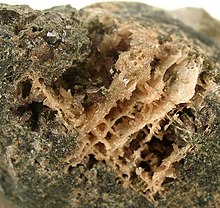
Sillimanite or fibrolite is an aluminosilicate mineral with the chemical formula Al2SiO5. Sillimanite is named after the American chemist Benjamin Silliman (1779–1864). It was first described in 1824 for an occurrence in Chester, Connecticut.

Galena, also called lead glance, is the natural mineral form of lead(II) sulfide (PbS). It is the most important ore of lead and an important source of silver.
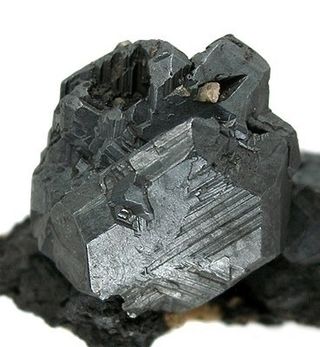
Chalcocite, copper(I) sulfide (Cu2S), is an important copper ore mineral. It is opaque and dark gray to black, with a metallic luster. It has a hardness of 2.5–3 on the Mohs scale. It is a sulfide with a monoclinic crystal system.
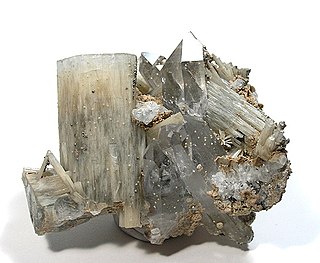
Zinnwaldite, KLiFeAl(AlSi3)O10(OH,F)2, potassium lithium iron aluminium silicate hydroxide fluoride is a silicate mineral in the mica group. The IMA status is as a series between siderophyllite (KFe2Al(Al2Si2)O10(F,OH)2) and polylithionite (KLi2AlSi4O10(F,OH)2) and not considered a valid mineral species.

Albite is a plagioclase feldspar mineral. It is the sodium endmember of the plagioclase solid solution series. It represents a plagioclase with less than 10% anorthite content. The pure albite endmember has the formula NaAlSi
3O
8. It is a tectosilicate. Its color is usually pure white, hence its name from Latin, albus. It is a common constituent in felsic rocks.

The mineral group tantalite [(Fe, Mn)Ta2O6] is the primary source of the chemical element tantalum, a corrosion (heat and acid) resistant metal. It is chemically similar to columbite, and the two are often grouped together as a semi-singular mineral called coltan or "columbite-tantalite" in many mineral guides. However, tantalite has a much greater specific gravity than columbite (8.0+ compared to columbite's 5.2). Iron-rich tantalite is the mineral tantalite-(Fe) or ferrotantalite and manganese-rich is tantalite-(Mn) or manganotantalite.

Lithiophilite is a mineral containing the element lithium. It is lithium manganese(II) phosphate with chemical formula LiMnPO4. It occurs in pegmatites often associated with triphylite, the iron end member in a solid solution series. The mineral with intermediate composition is known as sicklerite and has the chemical formula Li(Mn,Fe)PO4). The name lithiophilite is derived from the Greek philos (φιλός) "friend", as lithiophilite is usually found with lithium.

Sugilite ( SOO-gə-lyte, -jee-) is a relatively rare pink to purple cyclosilicate mineral with the complex chemical formula KNa2(Fe, Mn, Al)2Li3Si12O30. Sugilite crystallizes in the hexagonal system with prismatic crystals. The crystals are rarely found and the form is usually massive. It has a Mohs hardness of 5.5–6.5 and a specific gravity of 2.75–2.80. It is mostly translucent. Sugilite was first described in 1944 by the Japanese petrologist Ken-ichi Sugi (1901–1948) for an occurrence on Iwagi Islet, Japan, where it is found in an aegirine syenite intrusive stock. It is found in a similar environment at Mont Saint-Hilaire, Quebec, Canada. In the Wessels mine in Northern Cape Province of South Africa, sugilite is mined from a strata-bound manganese deposit. It is also reported from Liguria and Tuscany, Italy; New South Wales, Australia and Madhya Pradesh, India.
Saliotite is a rare colorless to pearl white phyllosilicate mineral in the smectite group with formula (Li,Na)Al3(AlSi3O10)(OH)5. It is an ordered 1:1 interstratification of cookeite and paragonite. It has perfect cleavage, a pearly luster and leaves a white streak. Its crystal structure is monoclinic, and it is a soft mineral with a hardness rated 2-3 on the Mohs scale.

Zabuyelite is the natural mineral form of lithium carbonate, with a formula Li2CO3. It was discovered in 1987 at Lake Zabuye, Tibet, after which it is named. It forms colorless vitreous monoclinic crystals.

Zirconolite is a mineral, calcium zirconium titanate; formula CaZrTi2O7. Some examples of the mineral may also contain thorium, uranium, cerium, niobium and iron; the presence of thorium or uranium would make the mineral radioactive. It is black or brown in color.
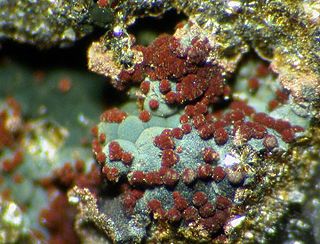
Robertsite, Ca3(Mn3+)4[(OH)3| (PO4)2]2·3(H2O) (alternatively formulated Ca2(Mn3(PO4)3O2)(H2O)3), is a secondary phosphate mineral named for Willard Lincoln Roberts (1923–1987), mineralogist and professor at South Dakota School of Mines in Rapid City, South Dakota.
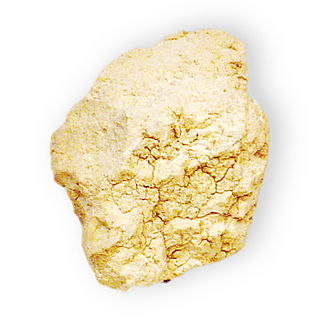
Hectorite is a rare soft, greasy, white clay mineral with a chemical formula of Na0.3(Mg,Li)3Si4O10(OH)2.
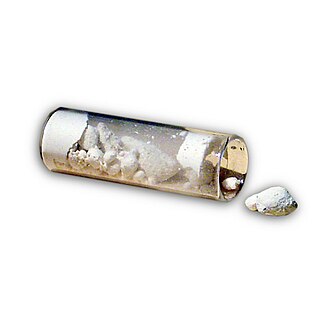
Taranakite is a hydrated alkali iron-aluminium phosphate mineral with chemical formula (K,Na)3(Al,Fe3+)5(PO4)2(HPO4)6·18 H2O. It forms from the reaction of clay minerals or aluminous rocks with solutions enriched in phosphate derived from bat or bird guano or, less commonly, from bones or other organic matter. Taranakite is most commonly found in humid, bat inhabited caves near the boundary of guano layers with the cave surface. It is also found in perennially wet coastal locations that have been occupied by bird colonies. The type location, and its namesake, the Sugar Loaf Islands off Taranaki, New Zealand, is an example of a coastal occurrence.

Minyulite is a rare phosphate mineral with a chemical formula of KAl2(PO4)2F·4(H2O).
Lithiophosphate is a natural form of (pure) lithium orthophosphate. It is an exceedingly rare mineral, occurring in some special types of pegmatites.
Faizievite is a very rare mineral with the formula K2Na(Ca6Na)Ti4Li6Si24O66F2. This triclinic mineral is chemically related to baratovite and katayamalite. Faizievite is a single-locality mineral, coming from the moraine of the Darai-Pioz glacier, Tien Shan Mountains, Tajikistan. Alkaline rocks of this site are famous for containing numerous rare minerals, often enriched in boron, caesium, lithium, titanium, rare earth elements, barium, and others.
Spheniscidite is a phosphate mineral. It is the ammonium analogue of leucophosphite.

Phosphosiderite is a rare mineral named for its main components, phosphate and iron. The siderite at the end of phosphosiderite comes from the word "sideros", the Greek word for iron. It was published in 1890, and has been a valid species since pre-IMA. It is an IMA approved mineral which got grandfathered, meaning its name is still believed to refer to an existing species.
